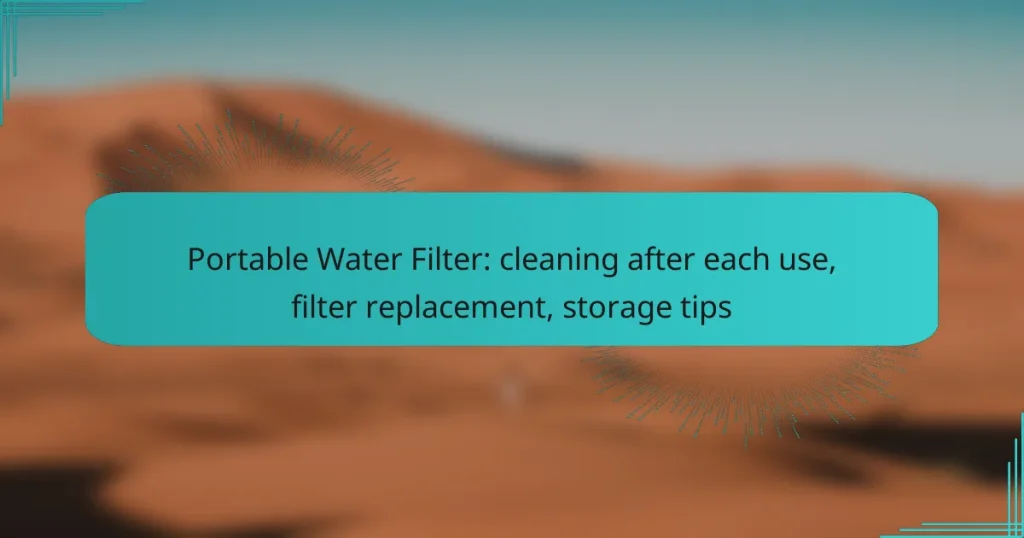Maintaining a portable water filter is crucial for ensuring safe drinking water and prolonging its lifespan. Regular cleaning after each use prevents contamination, while timely filter replacement based on capacity and performance is essential for optimal function. Additionally, proper storage in a cool, dry place, away from direct sunlight and with components disassembled, helps preserve the filter’s effectiveness.

How to clean a portable water filter after each use?
Cleaning a portable water filter after each use is essential to maintain its effectiveness and ensure safe drinking water. Regular cleaning prevents the buildup of contaminants and prolongs the filter’s lifespan.
Rinse with clean water
Start by rinsing the filter components with clean, preferably filtered water. This step helps remove any residual dirt or particles that may have accumulated during use. Make sure to rinse all parts, including the filter cartridge and any hoses or attachments.
It’s advisable to use water that is free from contaminants, as using unclean water can negate the benefits of the filter. A quick rinse under running water for about 30 seconds is usually sufficient.
Use a mild soap solution
After rinsing, prepare a mild soap solution using a few drops of dish soap mixed with warm water. Soak the filter components in this solution for a few minutes to help dislodge any remaining impurities. Avoid harsh chemicals or abrasive cleaners, as they can damage the filter.
Gently scrub the surfaces with a soft brush or cloth if necessary, ensuring that you reach all crevices. Rinse thoroughly with clean water afterward to remove any soap residue, which could affect the taste of future water filtered through the system.
Dry thoroughly before storage
Once cleaned, it’s crucial to dry the filter components completely before storing them. Moisture can promote mold and bacteria growth, compromising the filter’s effectiveness. Place the parts in a well-ventilated area or use a clean towel to pat them dry.
Allowing the components to air dry for several hours is ideal. Ensure that all parts are completely dry before reassembling or storing the filter to maintain its performance and hygiene.
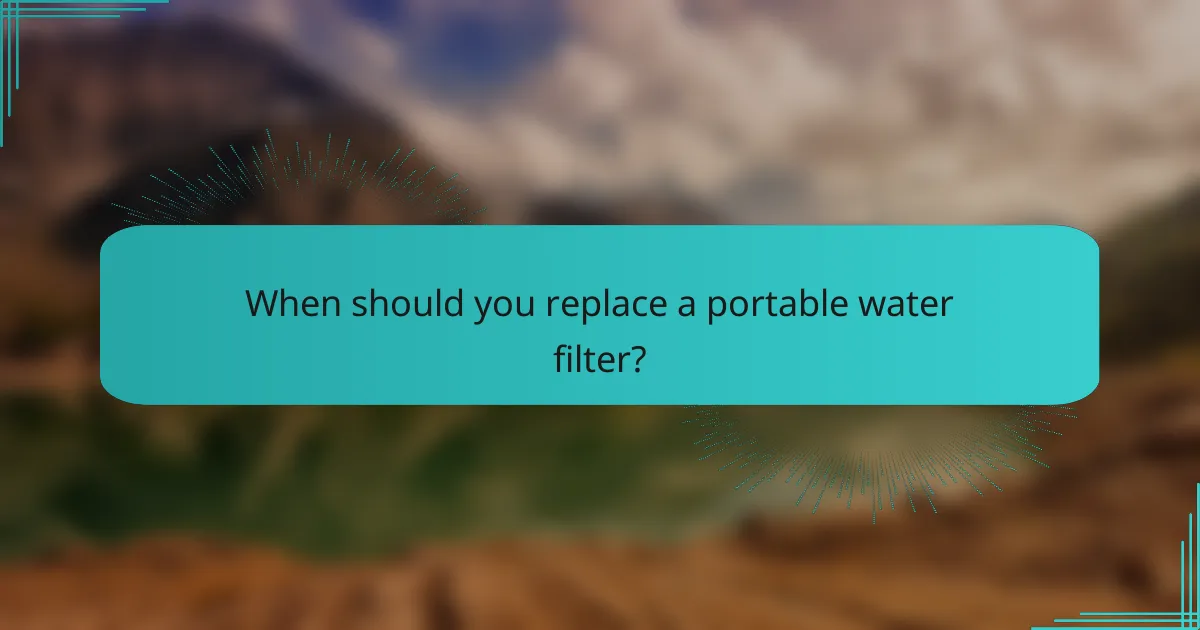
When should you replace a portable water filter?
You should replace a portable water filter when it reaches its maximum capacity, experiences a significant drop in flow rate, or according to the manufacturer’s guidelines. Regularly checking these factors ensures optimal performance and safe drinking water.
After a specific number of liters filtered
Most portable water filters have a specified capacity, often measured in liters. For example, many filters can effectively purify anywhere from 100 to 1,000 liters of water before needing replacement. Keeping track of the total liters filtered can help you determine when to replace the filter.
To make this easier, consider marking the date of first use on the filter or using a log to track usage. This proactive approach can prevent unexpected filter failures during critical times.
When flow rate decreases significantly
A noticeable decrease in flow rate is a clear indicator that your portable water filter may need replacement. If you find that it takes longer than usual to filter water, this could signal that the filter is clogged or nearing the end of its lifespan.
Regularly testing the flow rate can help you identify issues early. If the flow rate drops to a fraction of its normal speed, it’s advisable to replace the filter to ensure effective purification.
Based on manufacturer recommendations
Each portable water filter comes with specific guidelines from the manufacturer regarding replacement intervals. These recommendations are based on testing and can vary significantly between different models and brands.
Always refer to the user manual for your filter to understand the recommended replacement schedule. Following these guidelines helps maintain the filter’s effectiveness and ensures safe drinking water.
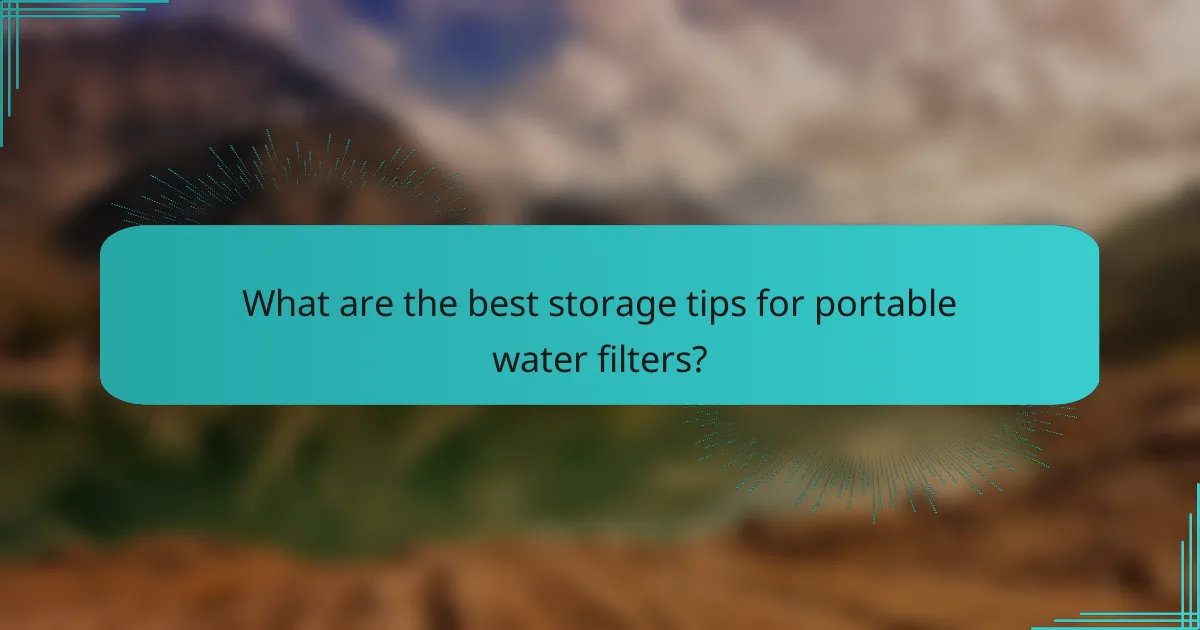
What are the best storage tips for portable water filters?
To ensure the longevity and effectiveness of portable water filters, proper storage is essential. Key practices include keeping the filter in a cool, dry place, avoiding direct sunlight, and storing components disassembled.
Store in a cool, dry place
Storing your portable water filter in a cool, dry location helps prevent mold and bacteria growth. Ideal storage temperatures typically range from 10°C to 25°C (50°F to 77°F). Avoid areas like garages or basements that may experience humidity or temperature fluctuations.
Consider using a dedicated storage container that is moisture-resistant. This adds an extra layer of protection against environmental factors that could compromise the filter’s integrity.
Avoid direct sunlight exposure
Direct sunlight can degrade the materials of your portable water filter, reducing its lifespan and effectiveness. Always store the filter in a shaded area or inside a bag that blocks UV rays. This is particularly important for filters with plastic components.
Using a dark cloth or a UV-resistant case can further shield the filter from harmful sunlight. Regularly check the storage area to ensure it remains free from direct light exposure.
Keep components disassembled
Disassembling your portable water filter before storage prevents parts from becoming warped or damaged. It also allows for thorough drying of each component, reducing the risk of mold and bacteria growth. Store each part in a separate, labeled bag for easy reassembly.
When reassembling, ensure all parts are completely dry to maintain optimal performance. Regularly inspect components for wear and tear, replacing any damaged parts as needed to ensure safe water filtration.
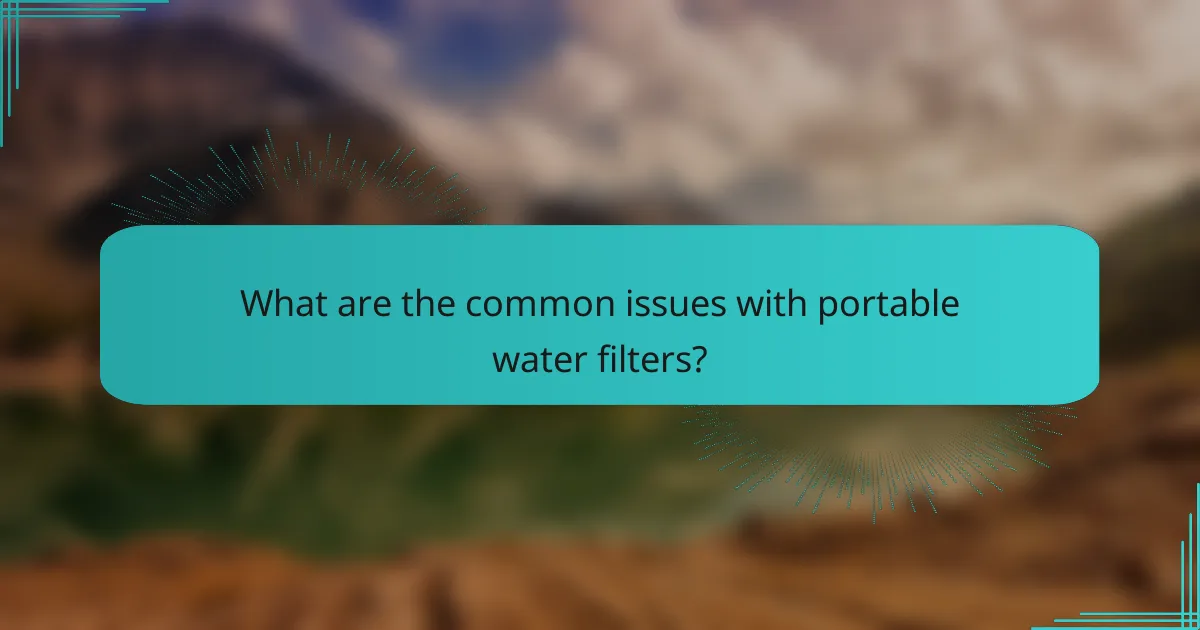
What are the common issues with portable water filters?
Portable water filters can face several common issues that affect their performance and safety. Understanding these problems is essential for maintaining effective filtration and ensuring clean drinking water.
Clogging from sediment
Clogging occurs when sediment, dirt, or other particulates accumulate in the filter, reducing water flow and filtration efficiency. This can happen more frequently in areas with high levels of sediment or during heavy rainfall.
To prevent clogging, regularly inspect and clean the filter after each use. If you notice a significant decrease in water flow, it may be time to backflush the filter or replace it, depending on the manufacturer’s guidelines.
Decreased filtration efficiency
Over time, the filtration efficiency of portable water filters can decline due to wear and tear or the accumulation of contaminants. This can lead to insufficient removal of harmful bacteria, viruses, and other impurities.
To maintain optimal filtration, replace the filter cartridge as recommended by the manufacturer, typically every few months or after filtering a specific volume of water. Regularly testing the water quality can also help determine if the filter is still effective.
Contamination from improper cleaning
Improper cleaning of portable water filters can lead to contamination, which defeats the purpose of using the filter. Residual water, dirt, or cleaning agents can introduce harmful substances back into the filtered water.
Always follow the manufacturer’s cleaning instructions, using only recommended cleaning solutions. After cleaning, ensure the filter is thoroughly dried and stored in a clean, dry place to prevent bacterial growth.
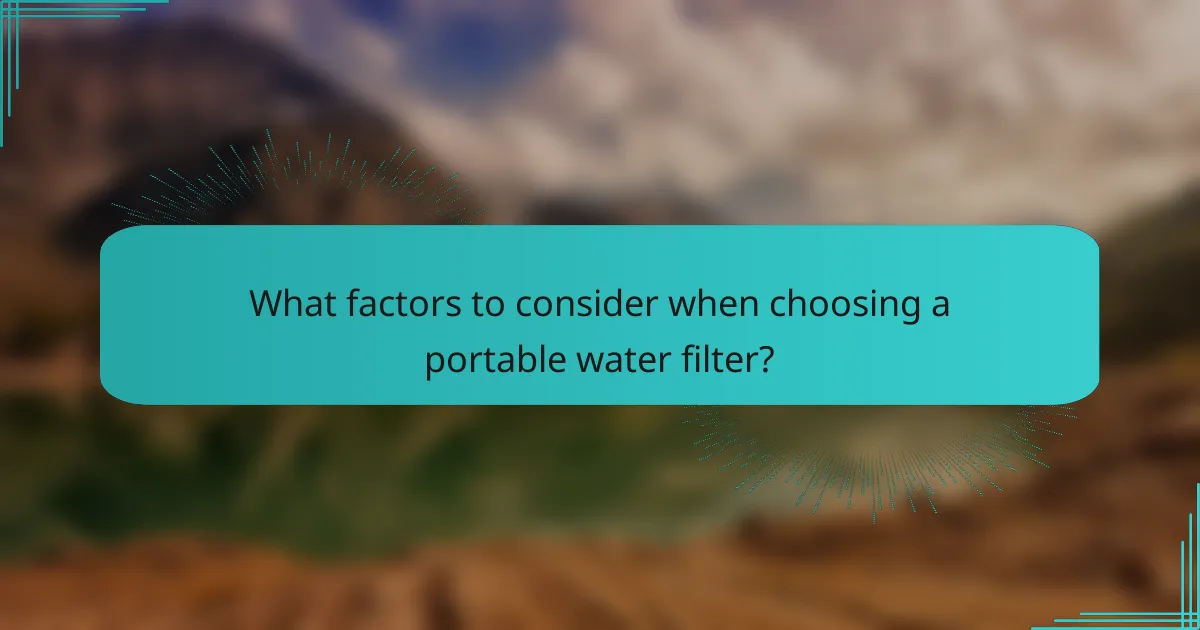
What factors to consider when choosing a portable water filter?
When selecting a portable water filter, consider filtration technology, weight, and the availability of replacement filters. These factors impact the filter’s effectiveness, ease of transport, and long-term usability.
Filtration technology type
Different filtration technologies include activated carbon, ceramic, and reverse osmosis. Activated carbon filters effectively remove chlorine and improve taste, while ceramic filters can eliminate bacteria and protozoa. Reverse osmosis systems are more comprehensive but often bulkier and slower.
Choose a technology based on your specific needs, such as the type of contaminants in your water source. For example, if you’re hiking in an area with potential bacterial contamination, a ceramic filter may be ideal.
Portability and weight
Portability is crucial for outdoor activities. Look for lightweight filters that are easy to pack and carry. Many portable water filters weigh between 200 to 500 grams, making them suitable for backpacking.
Consider the size and design as well; compact filters can fit into small bags, while larger models may be cumbersome. A good rule of thumb is to choose a filter that balances weight with capacity, ensuring you can carry enough water for your needs without excess bulk.
Replacement filter availability
Check the availability of replacement filters before purchasing a portable water filter. Some brands have easily accessible filters, while others may require ordering online, which can be inconvenient during trips.
Additionally, consider the lifespan of the filters. Some can last for hundreds of liters, while others may need replacement after just a few dozen uses. Always have a backup plan for filter replacements, especially if you plan extended outdoor activities.

What are the benefits of using a portable water filter?
Using a portable water filter provides access to clean drinking water, especially in areas where tap water may be contaminated. These filters effectively remove impurities, making water safer for consumption during outdoor adventures or emergencies.
Improved water quality
Portable water filters enhance water quality by removing bacteria, protozoa, and sediment. Many filters meet standards set by organizations like the EPA, ensuring they effectively reduce harmful contaminants. Regular use can significantly lower the risk of waterborne illnesses.
When selecting a filter, consider its filtration capabilities and the types of contaminants it targets. Some filters are designed for specific environments, such as backcountry hiking or urban settings, so choose one that fits your needs.
Convenience for outdoor activities
Portable water filters are essential for outdoor activities like camping, hiking, and backpacking. They allow users to source water from natural bodies, reducing the need to carry large amounts of water. This convenience can lighten your load and enhance your experience in the wilderness.
To maximize convenience, look for lightweight filters that are easy to use and maintain. Some models offer quick filtration times, allowing you to fill a water bottle in just a few minutes. Always check the filter’s capacity and replacement frequency to ensure it meets your activity duration.
